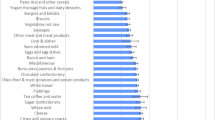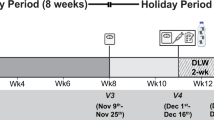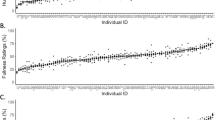Abstract
Background
In normal weight subjects it is known that day-to-day energy intake (EI) can vary substantially while this question has not been examined in obese subjects. From acute feeding experiments one would assume that these perturbations are mainly due to differences in food energy density (ED). However, food quantity (FQ) during single meals, number of meals, cognitive and sensory mechanisms may also contribute to the modification of EI.
Objective and design
To obtain more detailed information about day-to-day variations of food intake food diaries recorded during 10 consecutive days of 280 obese and 100 normal weight subjects were examined.
Results
The chronological analysis shows a fairly constant pattern for EI, FQ and ED in both groups. The group analysis, however, masks individual fluctuations since the coefficients of variation were between 20 and 24% for the three parameters, respectively. This corresponds to a range of 1,200 kcal. Sixty-five percent can be accounted for changes in FQ and 35% as the result of variations in ED. Snacks between main meals account for 20% of daily EI but only 10% of FQ. Furthermore, snack EI is not compensated during main meals.
Conclusion
Small day-to-day changes of EI are due to increased meal quantities while greater fluctuations are also due to higher food ED. The present data suggest that modification of FQ by cognitive and sensory factors plays an important role in the variation of daily EI under real life conditions with no major difference between normal weight and obese subjects.




Similar content being viewed by others
References
Berteus-Forslund H, Torgerson JS, Sjostrom L, Lindroos AK (2005) Snacking frequency in relation to energy intake and food choices in obese men and women compared to a reference population. Int J Obes (Lond) 29:711–719
Campfield LA (1999) Socratic debate: cognitive is more important than physiological regulation of appetite: con argument. In: Angel A, Anderson H, Bouchard C, Lau D, Leiter L, Mendelson R (eds) Progress in obesity research. John Libbey, London, pp 359–365
De Castro JM (2000) Eating behavior: lessons from the real world of humans. Nutrition 16:800–813
De Castro JM (2007) The time of day and the proportions of macronutrient eaten are related to total daily food intake. Br J Nutr 98:1077–1083
Drewnowski A (1997) Taste preferences and food intake. Annu Rev Nutr 17:237–253
Ello-Martin JA, Ledikwe JH, Rolls BJ (2005) The influence of food portion size and energy density on energy intake: implications for weight management. Am J Clin Nutr 82:236S–241S
Erdmann J, Hebeisen Y, Lippl F, Wagenpfeil S, Schusdziarra V (2007) Food intake and plasma ghrelin response during potato-, rice- and pasta-rich test meals. Eur J Nutr 46:196–203
Erdmann J, Leibl M, Wagenpfeil S, Lippl F, Schusdziarra V (2006) Ghrelin response to protein and carbohydrate meals in relation to food intake and glycerol levels in obese subjects. Regul Pept 135:23–29
Erdmann J, Töpsch R, Lippl F, Gussmann P, Schusdziarra V (2004) Postprandial response of plasma ghrelin levels to various test meals in relation to food intake, plasma insulin and glucose. J Clin Endocrinol Metab 89:3048–3054
Geliebter A (1988) Gastric distention and gastric capacity in relation to food intake in humans. Physiol Behav 44:665–668
Haveman-Nies A, de Groot LP, van Staveren WA (1998) Snack patterns of older Europeans. J Am Diet Assoc 98:1297–1302
Herman CP (1999) Cognitive is more important than physiological in the regulation of appetite. In: Angel A, Anderson H, Bouchard C, Lau D, Leiter L, Mendelson R (eds) Progress in obesity research. John Libbey, London, pp 379–383
Kant AK, Graubard BI (2005) Energy density of diets reported by American adults: association with food group intake, nutrient intake, and body weight. Int J Obes (Lond) 29:950–956
Kerver JM, Yang EJ, Obayashi S, Bianchi L, Song WO (2006) Meal and snack patterns are associated with dietary intake of energy and nutrients in US adults. J Am Diet Assoc 106:46–53
Kral TV, Roe LS, Rolls BJ (2004) Combined effects of energy density and portion size on energy intake in women. Am J Clin Nutr 79:962–968
Ledikwe JH, Blanck HM, Kettel Khan L, Serdula MK, Seymour JD, Tohill BC, Rolls BJ (2006) Dietary energy density is associated with energy intake and weight status in US adults. Am J Clin Nutr 83:1362–1368
Ledikwe JH, Rolls BJ, Smiciklas-Wright H, Mitchell DC, Ard JD, Champagne C, Karanja N, Lin PH, Stevens VJ, Appel LJ (2007) Reductions in dietary energy density are associated with weight loss in overweight and obese participants in the PREMIER trial. Am J Clin Nutr 85:1212–1221
Marr JW (1971) Individual dietary surveys: purposes and methods. World Rev Nutr Diet 13:105–164
Max Rubner-Institut, Bundesforschungsinstitut für Ernährung und Lebensmittel (2008) Nationale Verzehrs-Studie II-Ergebnisbericht, Teil 2. Max Rubner-Institut, Bundesforschungsinstitut für Ernährung und Lebensmittel, Berlin
Newby PK (2006) Examining energy density: comments on diet quality, dietary advice, and the cost of healthful eating. J Am Diet Assoc 106:1166–1169
Rolls BJ, Castellanos VH, Halford JC, Kilara A, Panyam D, Pelkman CL, Smith GP, Thorwart ML (1998) Volume of food consumed affects satiety in men. Am J Clin Nutr 67:1170–1177
Rolls BJ, Drewnowski A, Ledikwe JH (2005) Changing the energy density of the diet as a strategy for weight management. J Am Diet Assoc 105:S98–S103
Rolls BJ, Morris EL, Roe LS (2002) Portion size of food affects energy intake in normal-weight and overweight men and women. Am J Clin Nutr 76:1207–1213
Rolls BJ, Roe LS, Meengs JS (2006) Reductions in portion size and energy density of foods are additive and lead to sustained decreases in energy intake. Am J Clin Nutr 83:11–17
Rolls BJ, Rowe EA, Rolls ET, Kingston B, Megson A, Gunary R (1981) Variety in a meal enhances food intake in man. Physiol Behav 26:215–221
Ruidavets JB, Bongard V, Bataille V, Gourdy P, Ferrieres J (2002) Eating frequency and body fatness in middle-aged men. Int J Obes Relat Metab Disord 26:1476–1483
Schick RR, Schusdziarra V, Schröder B, Classen M (1991) Effect of intraduodenal or intragastric nutrient infusion on food intake in man. Z Gastroenterol 70:448–455
Schick RR, Schusdziarra V (1994) Regulation of food intake. In: Ditschuneit H, Gries FA, Hauner H, Schusdziarra V, Wechsler JG (eds) Obesity in Europe 1993. John Libbey, London, pp 335–348
Schusdziarra V, Sassen M, Hausmann M, Barth C, Erdmann J (2009) Food intake of overweight and obese subjects. Aktuel Ernahrungsmed 34:19–32 (German)
Schusdziarra V, Sassen M, Hausmann M, Wittke C, Erdmann J (2009) Food items, energy intake, food quantity and energy density during main meals and snacks of overweight and obese subjects. Aktuel Ernahrungsmed 34:186–194 (German)
Shide DJ, Rolls BJ (1995) Information about the fat content of preloads influences energy intake in healthy women. J Am Diet Assoc 95:993–998
Stubbs RJ, Johnstone AM, Mazlan N, Mbaiwa SE, Ferris S (2001) Effect of altering the variety of sensorially distinct foods, of the same macronutrient content, on food intake and body weight in men. Eur J Clin Nutr 55:19–28
Stubbs RJ, Johnstone AM, O’Reilly LM, Barton K, Reid C (1998) The effect of covertly manipulating the energy density of mixed diets on ad libitum food intake in ‘pseudo free-living’ humans. Int J Obes Relat Metab Disord 22:980–987
Stubbs RJ, Ritz P, Coward WA, Prentice AM (1995) Covert manipulation of the ratio of dietary fat to carbohydrate and energy density: effect on food intake and energy balance in free-living men eating ad libitum. Am J Clin Nutr 62:330–337
Young CM, Franklin RE, Foster WD, Steele BF (1953) Weekly variation in nutrient intake of young adults. J Am Diet Assoc 29:459–464
Author information
Authors and Affiliations
Corresponding author
Rights and permissions
About this article
Cite this article
Schusdziarra, V., Hausmann, M., Wittke, C. et al. Contribution of energy density and food quantity to short-term fluctuations of energy intake in normal weight and obese subjects. Eur J Nutr 49, 37–43 (2010). https://doi.org/10.1007/s00394-009-0046-6
Received:
Accepted:
Published:
Issue Date:
DOI: https://doi.org/10.1007/s00394-009-0046-6




